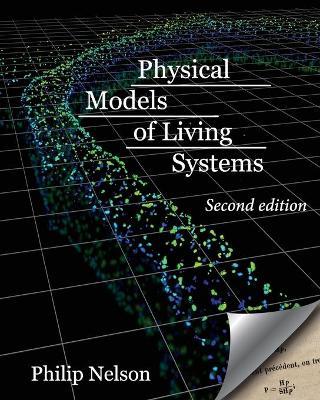Physical Models of Living Systems: Probability, Simulation, Dynamics

Physical Models of Living Systems: Probability, Simulation, Dynamics
Award-winning prof brings you from first-year classes to the frontiers of systems and synthetic biology, epidemic modeling, and imaging. Physical Models of Living Systems is a university textbook that integrates those cutting-edge topics with classic results in statistical inference, control theory, biophysical chemistry and mechanobiology, immunology, and neuroscience, as well as guiding you to create your own stochastic simulations. Instead of offering a huge pile of facts, the discovery-style exposition frequently asks you to reflect on "How could anything like that happen at all?" and then shows how scientists have incrementally peeled back the layers of mystery surrounding these beautiful mechanisms. Working through this book will give you an appreciation for how science has advanced in the past, and the skills and frameworks needed to push forward in the future.
Intended for intermediate-level undergraduates in any science or engineering major, the only prerequisite for this course is first-year physics. Supplementary sections make the book also suitable as the basis of a graduate-level course. This low-cost second edition expands the first one with four new chapters as well as adding add many clarifications and updates. Dozens of exercises are included at all levels of complexity, many involving computer work. Throughout, the goal is for you to gain the fluency needed to derive every result for yourself.
Along the way, you will acquire several research skills that are often not addressed in traditional courses: Basic modeling skills, including dimensional analysis, identification of variables, and ODE formulation;Probabilistic modeling skills, including stochastic simulation;Data analysis methods, including maximum likelihood and Bayesian methods;Computer programming using a general-purpose platform like MATLAB or Python, with short codes written from scratch;Dynamical systems, particularly feedback control, with phase portrait methods.
All of these basic skills, which are relevant to nearly any field of science or engineering, are presented in the context of case studies from living systems, including: Virus dynamics;Bacterial genetics and evolution of drug resistance;Statistical inference;Superresolution microscopy and cryo-electron microscopy;Stochastic simulation, for example of gene expression;Synthetic biology;Epidemic modeling;Naturally evolved cellular control circuits, including homeostasis, genetic switches, and the mitotic c
PRP: 328.54 Lei
Acesta este Prețul Recomandat de Producător. Prețul de vânzare al produsului este afișat mai jos.
262.83Lei
262.83Lei
328.54 LeiLivrare in 2-4 saptamani
Descrierea produsului
Award-winning prof brings you from first-year classes to the frontiers of systems and synthetic biology, epidemic modeling, and imaging. Physical Models of Living Systems is a university textbook that integrates those cutting-edge topics with classic results in statistical inference, control theory, biophysical chemistry and mechanobiology, immunology, and neuroscience, as well as guiding you to create your own stochastic simulations. Instead of offering a huge pile of facts, the discovery-style exposition frequently asks you to reflect on "How could anything like that happen at all?" and then shows how scientists have incrementally peeled back the layers of mystery surrounding these beautiful mechanisms. Working through this book will give you an appreciation for how science has advanced in the past, and the skills and frameworks needed to push forward in the future.
Intended for intermediate-level undergraduates in any science or engineering major, the only prerequisite for this course is first-year physics. Supplementary sections make the book also suitable as the basis of a graduate-level course. This low-cost second edition expands the first one with four new chapters as well as adding add many clarifications and updates. Dozens of exercises are included at all levels of complexity, many involving computer work. Throughout, the goal is for you to gain the fluency needed to derive every result for yourself.
Along the way, you will acquire several research skills that are often not addressed in traditional courses: Basic modeling skills, including dimensional analysis, identification of variables, and ODE formulation;Probabilistic modeling skills, including stochastic simulation;Data analysis methods, including maximum likelihood and Bayesian methods;Computer programming using a general-purpose platform like MATLAB or Python, with short codes written from scratch;Dynamical systems, particularly feedback control, with phase portrait methods.
All of these basic skills, which are relevant to nearly any field of science or engineering, are presented in the context of case studies from living systems, including: Virus dynamics;Bacterial genetics and evolution of drug resistance;Statistical inference;Superresolution microscopy and cryo-electron microscopy;Stochastic simulation, for example of gene expression;Synthetic biology;Epidemic modeling;Naturally evolved cellular control circuits, including homeostasis, genetic switches, and the mitotic c
Detaliile produsului









